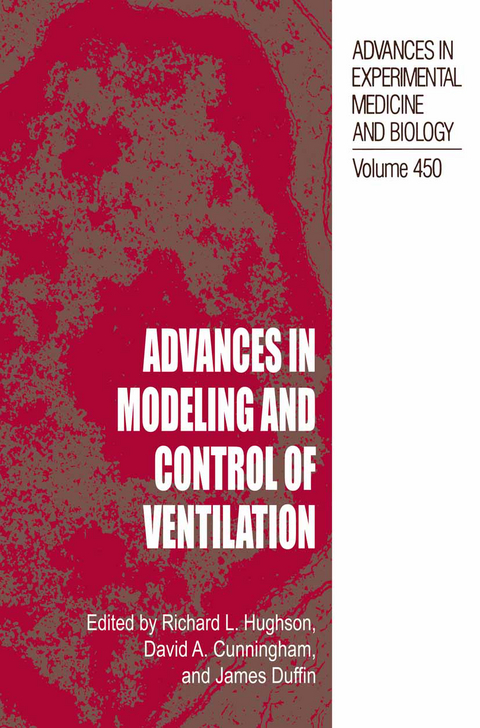
Advances in Modeling and Control of Ventilation
Kluwer Academic/Plenum Publishers (Verlag)
978-0-306-46023-4 (ISBN)
The seventh "Oxford Conference" on Modeling and Control of Ventilation was held in the beautiful setting of Northem Ontario at the Grandview Inn in Hunstville. This meet- ing was called the Canadian Conference on Modeling and Control ofVentilation (CCMCV) to follow on LCMCV held in London, England, three years ago. The beautiful view over Fairy Lake greeted everyone in the moming and provided an ideal setting for many discus- sions about respiratory physiology and modeling. The Oxford Conferences began in 1971 when Dr. Richard Hercynski (a mathematical modeler with an interest in respiratory physiology) and Dr. Dan Cunningham (a respiratory physiologist with an interest in modeling) decided to organize a meeting "Modelling of a Biological Control System: Tbe Regulation of Breathing" in Oxford, England, in 1978. The meeting was a success, and it spawned aseries of meetings that have continued to today. A second conference was organized at Lake Arrowbead, Califomia, in 1982. After tbis, con- ferences were repeated at tbree-year intervals. My first Oxford Conference was at tbe abbey in Solignac, France, in 1985. Next, we met in tbe cabins overlooking Grand Lake, Colorado, in 1988.
In 1991, we traveled to the training institute at the base ofMt. Fuji (or at least they tell us Mt. Fuji was out there--we never saw it because of a typhoon rolling through). Our last meeting was at Royal Holloway College (University of London) where we got to dine in a castle among artwork that required guards and an electronic security system.
1. Effect of Prior O2 Breathing on Hypoxic Hypercapnic Ventilatory Responses in Humans.- 2. Inhibitory Dopaminergic Mechanisms Are Functional in Peripherally Chemodenervated Goats.- 3. Effect of 8 Hours of Isocapnic/Poikilocapnic Hypoxia on the Ventilatory Response to CO2.- 4. Ventilatory Responses to Hypoxia after 6 Hours Passive Hyperventilation in Humans.- 5. Ventilatory Effects of 8 Hours of Isocapnic Hypoxia with and without ß-Blockade.- 6. Modulation of Ventilatory Sensitivity to Hypoxia by Dopamine and Domperidone before and after Prolonged Exposure to Hypoxia in Humans.- 7. Changes in Respiratory Control during and after 48 Hours of Both Isocapnic and Poikilocapnic Hypoxia in Humans.- 8. Chemoreflex Effects of Low Dose Sevoflurane in Humans.- 9. Dynamics of the Cerebral Blood Flow Response to Sustained Euoxic Hypocapnia in Humans.- 10. Evidence for a Central Role of Protein Kinase C in Modulation of the Hypoxic Ventilatory Response in the Rat.- 11. Synaptic Connections to Phrenic Motoneurons in the Decerebrate Rat.- 12. Phrenic Nerve Response to Glutamate Antagonist Microinjection in the Ventral Medulla.- 13. Axonal Projections from the Pontine Parabrachial-Kölliker-Fuse Nuclei to the Bötzinger Complex as Revealed by Antidromic Stimulation in Cats.- 14. Hebbian Covariance Learning: A Nexus for Respiratory Variability, Memory, and Optimization?.- 15. Performances of Different Control Laws for Automatic Oxygen Supply for COPD Patients.- 16. Techniques for Assessing the Shape of Respiratory Flow Profiles from Data Containing Marked Breath-by-Breath Respiratory Variability.- 17. The Expiratory Flow Pattern and the Neuromuscular Control of Breathing in Cats.- 18. Phase Relations between Rhythmical Forearm Movements and Breathing under Normacapnic and HypercapnicConditions.- 19. Temporal Correlation in Phrenic Neural Activity.- 20. Methods of Assessing Respiratory Impedance during Flow Limited and Non-Flow Limited Inspirations.- 21. Human Ventilatory Response to Immersion of the Face in Cool Water.- 22. Ventilatory Response to Passive Head Up Tilt.- 23. Do Sex-Related Differences Exist in the Respiratory Pharmacology of Opioids?.- 24. Are the Respiratory Responses to Changes in Ventilatory Assist Optimized?.- 25. Selective Depression of Peripheral Chemoreflex Loop by Sevoflurane in Lightly Anesthetized Cats.- 26. Pulmonary Rapidly Adapting Receptors and Airway Constriction.- 27. The Effect of Eucapnic and Isocapnic Volitional Hyperventilation upon Breathlessness.- 28. Influence of Low Dose Dopamine on the Heart Rate and Ventilatory Responses to Sustained Isocapnic Hypoxia.- 29. Ondine’s Curse and Its Inverse Syndrome: Respiratory Failure in Autonomic vs. Voluntary Control.- 30. Chemoreflex Model Parameters Measurement.- 31. Ventilatory Response to Imagination of Exercise and Altered Perception of Exercise Load under Hypnosis.- 32. Cardiolocomotor Interactions during Dynamic Handgrip and Knee Extension Exercises: Phase-Locked Synchronization and Its Physiological Implications.- 33. V?e-V?co2 Relationship in Transient Responses to Step-Load Exercise from Rest to Recovery.- 34. The Influence of Hypercapnic Hyperpnea on the Interaction between Breathing and Finger Tracking Movements in Humans.- 35. Characteristics of the VO2 Slow Component during Heavy Exercise in Humans Aged 30 to 80 Years.- 36. Voice, Breathing, and the Control of Exercise Intensity.- 37. Pulmonary Training May Alter Exertional Dyspnea and Fatigue via an Exercise-like Training Effect of a Lowered Heart Rate.
| Erscheint lt. Verlag | 31.10.1998 |
|---|---|
| Reihe/Serie | Advances in Experimental Medicine and Biology ; 450 |
| Zusatzinfo | XIII, 241 p. |
| Verlagsort | New York |
| Sprache | englisch |
| Maße | 156 x 234 mm |
| Themenwelt | Medizin / Pharmazie ► Medizinische Fachgebiete |
| Studium ► 1. Studienabschnitt (Vorklinik) ► Physiologie | |
| ISBN-10 | 0-306-46023-8 / 0306460238 |
| ISBN-13 | 978-0-306-46023-4 / 9780306460234 |
| Zustand | Neuware |
| Haben Sie eine Frage zum Produkt? |
aus dem Bereich


